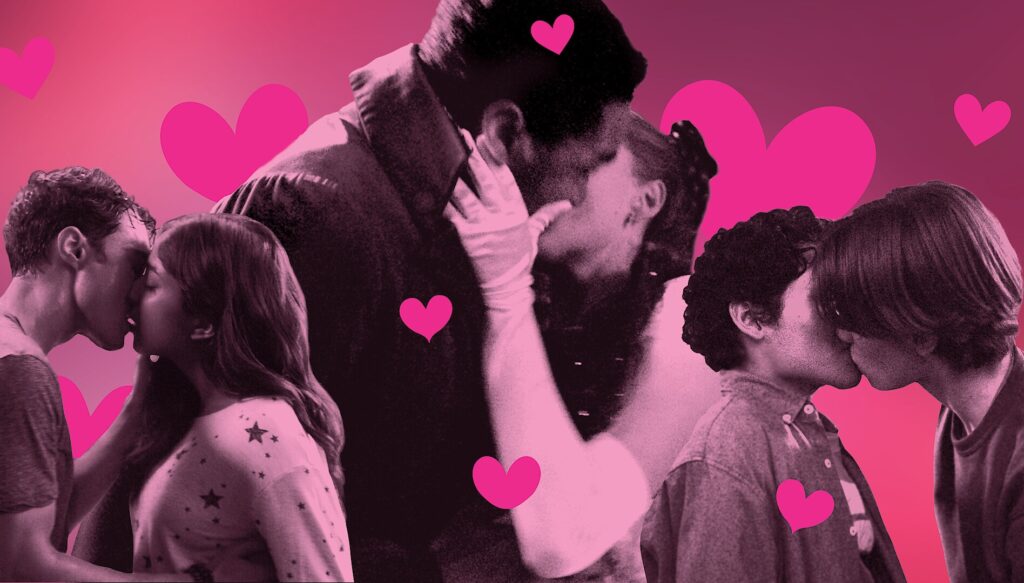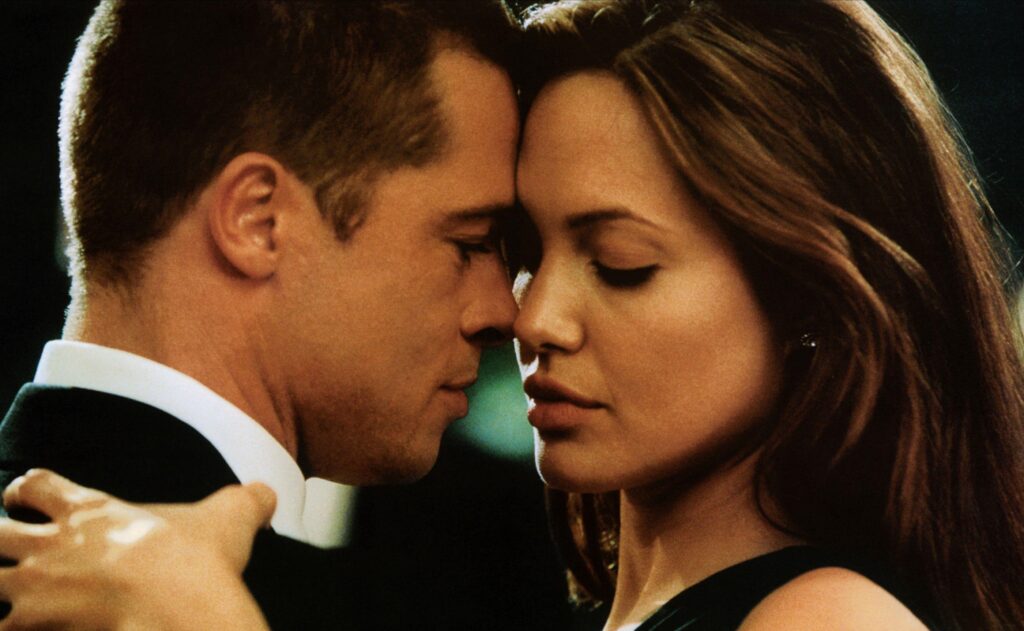The art of writing, especially in romantic contexts, requires a gentle touch and a nuanced understanding of human emotions. One of the most pivotal moments in many stories, irrespective of their primary genre, is the kissing scene.
It’s not just the physical act of two lips meeting but a culmination of tension, emotion, and anticipation. Writing it well can elevate a story, drawing readers into the depth of the characters’ feelings. Let’s embark on a journey to learn the step-by-step process of penning down that perfect, spine-tingling kiss.

How to Write a Kissing Scene (Step-by-Step)

Build the Tension:
A kiss rarely happens out of the blue. The moments leading up to it can be filled with anticipation. Build on this tension through subtle hints like lingering glances, playful teasing, or a heightened sense of proximity. This emotional buildup provides a foundation, making the eventual kiss all the more satisfying for your readers.
Remember, the slow burn often leads to the most rewarding flames.
Context Matters:
The circumstances surrounding the kiss will shape its mood and significance. A stolen kiss in a time of war will feel different from a passionate embrace in a romantic setting.
Ask yourself: What has led these characters to this moment? Is there history? Is it a moment of solace, passion, or a blend of various emotions? By establishing the context, you provide depth and layers to the scene.
Stay True to the Characters:
Remember the personal histories, temperaments, and past experiences of your characters. A shy character might hesitate, taking longer to lean in, while a more assertive character might initiate without hesitation. Their individual journeys should influence their actions. This ensures that the kiss feels genuine and true to the narrative you’ve built around each character.
Engage the Senses:
A kiss is a sensory experience. Describe the softness of their lips, the taste of a recently consumed drink, or the faint scent of their perfume or cologne. Maybe there’s a distant sound that contrasts the closeness of the moment, like a bird’s call or city traffic.
Expert Tip: By painting a multi-sensory picture, you immerse the reader completely, making them feel as if they’re right there with the characters.
Avoid Clichés:
While clichés became popular for a reason, they can make a scene feel uninspired if overused. Instead of falling back on stock phrases, strive to capture the unique essence of this specific kiss between these particular characters. How is it different from any other kiss in any other story?
Keep It Real:
Perfection can sometimes be dull. Maybe the characters are out of breath from running, or one of them gets a bit nervous and has to clear their throat. These tiny, real-life details can make the scene more relatable and endearing.
Convey Emotional Reactions:
After the physical connection ends, the emotional journey begins. Dive into the whirlwind of feelings. Is there a sense of euphoria? Or a sudden realization? Maybe one character is analyzing the implications of the kiss, while the other is lost in the moment. The aftermath often holds as much weight as the act itself.
Consider the Setting:
The environment is a silent participant in the scene. Whether it’s a quiet corner in a bustling city, a serene lakeside, or a rainy street corner the setting can amplify the emotions. Use descriptive language to paint the surroundings, giving readers not just the act of the kiss, but the world in which it unfolds.
Revise and Refine:
First drafts are just that a starting point. Once you’ve penned down the scene, take a break, then come back with fresh eyes. Reading it aloud can also help you catch any awkward phrasings or pacing issues. Feedback from trusted friends or beta readers can provide new perspectives, helping you fine-tune the scene to perfection.
Crafting a compelling kissing scene requires patience, insight, and a touch of creativity. By deepening your understanding of context, character, and emotion, you can write a scene that not only captures a pivotal moment but resonates deeply with readers, making them root for your characters even more.
How to Get Rid of Clichés and Write a Heartfelt Kissing Scene (9 Tips)

Understand the Characters:
Before setting pen to paper, delve deep into the psyche of your characters. What are their fears, desires, and histories? A well-understood character will naturally steer clear of clichéd responses. The more you know about them, the more original and authentic their reactions and feelings will be during the kiss.
Engage in People-Watching:
Observe real-life couples or watch realistic romantic films and series. Notice the nuances, the hesitations, and the ways people react differently to intimate moments. Drawing inspiration from real life can lend a sense of authenticity to your scene.
Use Unique Metaphors:
Instead of “fireworks exploded” or “butterflies in the stomach”, think of fresh metaphors that resonate with your story’s setting or your characters’ experiences. If a character is a pianist, maybe the kiss feels like a perfect chord. If they’re from a coastal town, perhaps it’s like the gentle pull of the tide.
Highlight the Imperfections:
Real life is messy, and real kisses can be too. Maybe their noses bump or they laugh midway because of a stray hair. These little imperfections can make the moment feel genuine and lived-in, as opposed to the over-idealized versions often portrayed.
Set the Scene with Originality:
While moonlit beaches or rainy rooftops have their charm, think of settings that are unique to your story. Perhaps it’s in a quiet bookstore aisle, amidst the aroma of old books, or during a hike when they’ve reached a viewpoint, surrounded by the sounds of nature.
Dive Deep into Sensory Descriptions:
Move beyond just the feel of their lips. Describe the warmth shared between their faces, the texture of a thumb brushing against a cheek, or the rhythmic sound of their breath syncing. Dive deep into sensory details to bring the scene to life.
Capture the Emotional Aftermath:
A kiss isn’t just about the physical act; it’s about what comes after. Delve into their introspection. Are they reevaluating their relationship? Is there an epiphany? Maybe it’s just a surge of warmth or a moment of vulnerability. This aftermath can be as profound as the kiss itself.
Be Conscious of Pacing:
Don’t rush to the moment. The buildup, the crescendo, and the eventual calm after the storm all have their place. By controlling the pacing, you allow readers to experience the entire emotional rollercoaster, making the scene more impactful.
Revise with Fresh Eyes:
After writing, take a break and return to it later. Approach the scene as a reader rather than a writer. Ask yourself: Does it feel genuine? Are there any phrases or descriptions that feel overused? Revising with a fresh perspective can help identify and eliminate clichés.
A heartfelt kissing scene is not about creating a picture-perfect moment, but rather a genuine, emotional experience for both the characters and the readers.
Expert Tip: By rooting the scene in authenticity, focusing on the characters’ unique perspectives, and drawing from real-life inspirations, you can craft a memorable, cliché-free moment that resonates deeply.
How to Write a Kiss Expression:

Writing about a kiss goes beyond just describing the physical act. It’s about capturing the feelings, sensations, and emotions of the characters. When you express a kiss in writing:
Focus on the Lead-up:
A lot can be said in the seconds before lips meet. The nervous glance, a shaky breath, the closing of eyes, or a hand reaching to cradle a face. These actions can say as much, if not more, than the kiss itself.
- Example: “She hesitated, her gaze flitting to his lips before meeting his eyes. Drawing a shaky breath, she tilted her head slightly, inviting the inevitable.”
Engage the Senses:
Describe the sensory experience. The softness or roughness of lips, the scent enveloping them, the faint tastes, the sounds in the backdrop.
- Example: “His lips were surprisingly soft, a contrast to the rough stubble of his chin. She could taste the lingering hint of mint, and in the distance, a song played, wrapping them in its melody.”
Convey Emotion:
Dive into what the characters are feeling. Is it a mix of fear and excitement? Is there relief in finally having the moment or apprehension of the consequences?
- Example: “As they parted, a flurry of emotions raced through her – elation, surprise, and a hint of sadness, wondering why they hadn’t crossed this threshold sooner.”
How Actors Fake Kissing Scenes:

Actors often have to portray intimate scenes on screen that may not mirror their real-life relationships with their co-stars. Here’s how they typically approach kissing scenes:
- Discussion and Consent: Before filming, actors, directors, and sometimes intimacy coordinators discuss the scene to ensure everyone is comfortable. Boundaries are set, and it’s essential to ensure mutual respect and understanding.
- Technical Approach: Actors often approach kissing scenes technically. They’ll discuss who turns which way, how close they get, and other logistical details. This technical focus helps to separate personal feelings from the act.
- Use of Camera Angles: Filmmakers can use camera angles and blocking to create the illusion of a kiss without the actors’ lips meeting. From the right angle, it can look like a deep kiss when it’s just a near-miss.
- Minimal Tongue: In many on-screen kisses, especially between actors who aren’t in a relationship off-screen, the use of the tongue is minimal or non-existent. This is a professional courtesy and often a mutual decision made before filming.
- Intimacy Coordinators: More and more film and TV sets are employing intimacy coordinators to ensure the comfort and safety of actors during intimate scenes. They help choreograph the scene to look genuine while ensuring actors’ boundaries are respected.
- Mental Separation: Actors train to separate their professional tasks from personal feelings. While they aim to portray genuine emotion, it’s essential to remember that they’re in character and the emotions aren’t necessarily their own.
- Aftercare: After shooting an intimate scene, actors might engage in small rituals or practices to shake off the character’s emotions, like changing clothes, washing their faces, or even just taking a moment to breathe and reset.
In both writing a kiss and portraying it on screen, the goal is authenticity. Whether it’s through words or acting, the aim is to capture the emotion and significance of the moment, making it resonate with the audience.
Do actors get turned on during makeout scenes?
Acting is a profession, and actors train extensively to portray emotions and physical actions without necessarily internalizing them. However, actors are also human, so physical reactions can sometimes occur, just as they might in any close-contact situation.
That being said, most actors approach intimate scenes professionally and focus on the technical aspects, such as camera angles, movement coordination, and delivering the scene effectively. It’s essential to understand that there’s a difference between an actor’s portrayal on screen and their personal feelings or reactions.
Why do more actors refuse to kiss on screen?

There are various reasons why an actor might refuse to participate in on-screen kissing or intimate scenes:
- Personal Beliefs: Some actors, due to religious or personal convictions, choose not to engage in on-screen intimacy. They might believe that certain acts should be reserved for personal relationships or view them as sacred.
- Comfort Levels: Intimate scenes can be demanding both emotionally and physically. Not every actor feels comfortable performing such scenes, and it’s crucial to respect their boundaries.
- Past Trauma: Some actors might have had traumatic experiences in the past, and on-screen intimacy might trigger those memories or emotions. Avoiding such scenes can be a way of protecting their mental and emotional well-being.
- Typecasting: Actors often avoid being pigeonholed into specific roles or being recognized only for certain kinds of scenes. By refusing to participate in intimate scenes, they might be trying to diversify their roles and avoid being typecast.
- Health Concerns: Sometimes, actors might refuse a kissing scene due to health reasons, such as if they or their co-star are sick or if there’s a risk of transmitting contagious illnesses.
- Contractual Stipulations: Some actors have specific clauses in their contracts that prohibit certain types of scenes, including intimacy.
- Professional Image: Some actors believe that participating in intimate scenes might affect their professional image or the way their fans perceive them. They might refuse such scenes to maintain a particular public image.
- Increase in Intimacy Coordinators: With the rise of intimacy coordinators in the film industry, there’s more awareness and discussion about boundaries and consent. This has made it more acceptable for actors to voice their concerns and set limits regarding on-screen intimacy.
Expert Tip: Actors’ choices to engage or not engage in specific scenes, including intimate ones, should be respected. Their decisions often stem from a combination of professional judgment and personal reasons.
How do actors mentally prepare themselves before performing intimate scenes?
Before performing intimate scenes, actors often undergo various mental preparation techniques. They may engage in dialogue with their co-stars to establish mutual trust and understanding. It’s essential to ensure that both parties are on the same page regarding the scene’s demands.
Some actors may also practice mindfulness techniques, like meditation, to calm their nerves and remain focused on the character and scene rather than personal emotions. Additionally, reviewing the script and understanding the significance of the scene in the story’s context can also help. It reinforces the idea that the intimate scene serves a narrative purpose, not just a gratuitous act.
Are there specific workshops or training sessions that actors attend to handle intimate scenes better?
Yes, there are specialized workshops and training sessions tailored to help actors navigate the complexities of intimate scenes. With the rise of intimacy coordinators in the film and theater world, many training programs aim to teach actors how to maintain boundaries, communicate effectively, and approach intimate scenes with professionalism and sensitivity.
These workshops may involve role-playing, discussions on consent, and techniques to establish physical and emotional safety.
How does the rise of the #MeToo movement impact the portrayal of intimate scenes in modern cinema?
The #MeToo movement has had a profound impact on the entertainment industry, shedding light on issues of harassment, coercion, and the importance of clear boundaries. As a result, there’s been a significant shift in how intimate scenes are approached. The movement emphasized the importance of consent, communication, and respect.
This led to the rise of intimacy coordinators on set, professionals who ensure that actors feel safe and that intimate scenes are choreographed to respect everyone’s boundaries. Moreover, scripts and storylines are now more scrutinized to ensure that intimate scenes are essential to the narrative and not just included for shock value or titillation.
How do directors ensure that intimate scenes align with the broader narrative of the story and aren’t gratuitous?
Directors, in collaboration with scriptwriters and sometimes intimacy coordinators, evaluate the significance of every scene in the context of the story.
For intimate scenes, they consider questions like Does the scene advance character development? Does it serve a thematic purpose? Does it move the plot forward? If the scene doesn’t meet such criteria, it might be deemed gratuitous and potentially be revised or removed.
The aim is to ensure that every element of the film or TV show, including intimate scenes, serves the broader narrative.
How do film crews ensure discretion and respect during the filming of intimate scenes?
Film crews often take several measures to maintain discretion during intimate scenes. Closed sets, where only essential crew members are allowed, are commonly used. This ensures that the actors are exposed to the smallest number of people possible. Crew members are often briefed beforehand about the sensitive nature of the scene and reminded to act professionally.
Monitors might be positioned such that only the director and essential personnel can view the scene as it’s being filmed. Overall, the aim is to create a safe, respectful environment where actors can perform without feeling overly exposed or uncomfortable.
Do intimacy coordinators work exclusively on intimate scenes, or do they have broader roles on set?
While the primary role of an intimacy coordinator is to oversee intimate scenes, ensuring the comfort and safety of actors, their responsibilities often extend beyond just those moments. They might collaborate with directors and actors on scenes that are emotionally charged or potentially triggering, even if they don’t involve physical intimacy.
They may also provide guidance on other sensitive topics portrayed in the script, ensuring respectful and accurate representation. Furthermore, intimacy coordinators may also offer training or workshops for crew members, fostering a set-wide environment of awareness and respect.
What role do costume departments play in facilitating comfortable intimate scenes?
Costume departments play an integral role in ensuring actor comfort during intimate scenes. They might provide actors with specific undergarments or barriers that allow for the portrayal of intimacy while ensuring a level of separation between actors.
Modesty garments, such as flesh-toned underwear or nipple covers, are commonly used to give the illusion of nudity or near-nudity while preserving the actor’s modesty.
The costume department collaborates closely with the director, actors, and intimacy coordinators to ensure that wardrobe choices align with the scene’s requirements while prioritizing actor comfort and dignity.
Conclusion
In the intricate tapestry of filmmaking, portraying intimacy is an art that requires a delicate balance of narrative purpose, actor comfort, and audience perception. As cinema evolves, the industry’s approach to intimate scenes is becoming more nuanced, prioritizing respect, consent, and authenticity.
The rise of specialized roles like intimacy coordinators, coupled with increased awareness and training, signifies a positive shift towards holistic storytelling. Whether you’re a viewer, writer, director, or actor, understanding the intricacies behind these scenes enriches your appreciation of the craft.
In the end, the goal remains the same: to tell compelling, genuine stories that resonate with audiences, even in moments as intimate as a kiss.
